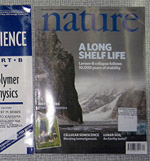Should conservation focus on threatened species? The case of Borneo...
 Southern pig-tailed macaque (Macaca nemestrina), a threatened mammal on BorneoConservation efforts tend to focus on threatened species. Environmental laws in the United States are a good example of this philosophy in which regulations and dollars are directed at a relatively small number of higher-profile, at-risk species.
Southern pig-tailed macaque (Macaca nemestrina), a threatened mammal on BorneoConservation efforts tend to focus on threatened species. Environmental laws in the United States are a good example of this philosophy in which regulations and dollars are directed at a relatively small number of higher-profile, at-risk species.
But some people in the field have raised questions about whether this is the best approach. One worry is that a focus on threatened species may not be cost-effective. Another concern is whether this approach leads to inequities - in other words it may cause us to not give enough attention to many non-threatened species putting them at risk.
A new study tackles this issue with respect to the conservation of mammals in East Kalimantan, Indonesia. The study area located on the island of Borneo is home to a high level of biodiversity and species endemism. It also faces one of the highest deforestation rates in the world - largely from unsustainable logging and land clearance for agriculture.
The researchers tested the cost effectiveness of three different conservation approaches: 1) a focus exclusively on threatened mammals; 2) a focus on non-threatened mammals; and 3) a focus on both threatened and non-threatened mammals. They used Marxan panning software to find the best outcome for each approach based on three different scenarios:
Scenario 1 - protect 30% of the area of occupancy of target species
Scenario 2 - protect sufficient habitat to support 500 individuals of target species
Scenario 3 - protect sufficient habitat to support 2000 individuals of target species
Interestingly, they found that for all the scenarios, focusing exclusively on threatened mammals also met the conservation targets of over 90% of the non-threatened species. In addition, focusing exclusively on threatened species required 38% less land protection to meet conservation targets.
While this study appears to validate a threatened species focus for mammal conservation in East Kamilantan, the researchers warn against generalizing the findings to a larger geographical or biological context.
What does this mean for conservation in Borneo?
Unfortunately, the study findings offer some bleak news for the conservation prospects in East Kalimantan. Meeting the modest conservation targets set in Scenario 2 (supporting 500 individuals of all mammalian species) would require protection of 95% of the remaining forested area in the province. This is an unlikely outcome unless the approach to natural resources in the area is fundamentally changed, for example through greater adoption of sustainable forestry and payments for ecosystem services.
On the positive side, this study helps develop a road map for conservation efforts in the area. The use of the Marxan approach for various scenarios shows the lands that would need to be protected to meet the different conservation targets. This will help inform conservation planning efforts. The researchers do concede, however, that a missing component in their analysis is the risk of future deforestation. They state:
"Although our conservation-priority map is a useful step forward, the missing link is including the risk of deforestation implicitly in the area-selection analysis. Planners should then be able to design a reserve system that provides some measure of its likeliness to succeed in the face of pressure from conflicting land uses."
--Reivewed by Rob Goldstein
DRUMMOND, S., WILSON, K., MEIJAARD, E., WATTS, M., DENNIS, R., CHRISTY, L., & POSSINGHAM, H. (2009). Influence of a Threatened-Species Focus on Conservation Planning Conservation Biology DOI: 10.1111/j.1523-1739.2009.01346.x




 Mammals
Mammals
Reader Comments